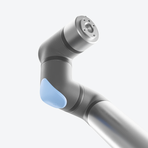Once companies automate processes with robotics, they don’t look back. They quickly learn to depend on the consistent, reliable output, day after day, and year after year. But that means dependability is more important than ever. Companies simply can’t afford the downtime that will impact productivity and profitability.
When You Can’t Afford Downtime, Even in Tough Conditions

Once companies automate processes with robotics, they don’t look back. They quickly learn to depend on the consistent, reliable output, day after day, and year after year. But that means dependability is more important than ever. Companies simply can’t afford the downtime that will impact productivity and profitability. One of the less-known benefits of collaborative robots is their nearly maintenance-free operation and long-term reliability. That’s true even in the toughest, dirtiest environments that would put any human worker to the test.
Nick Armenta, an automation engineer with UR distributor Olympus Controls, explains that the company’s experience with the robots’ durability is common. “We very often see the robots operate in harsh environments, taking over jobs that humans don’t want to perform,” he says. “Many think of cobots as being fragile but the opposite is true: this is an extremely durable robot. It’s sealed against dust, rated for high temperatures, and works just as well in extreme environments as in a cleanroom.”
HOT, DUSTY ENVIRONMENT DOESN’T SLOW DOWN PLASMA SPRAY ROBOT
Aircraft Tooling (ATI), a Texas-based repair center for the aviation industry and Olympus Controls customer was surprised to find that UR cobots could withstand the high temperatures and harsh environment of its metal powder and plasma spray processes. “It simply looked too clean,” thought Juan Puente while he was researching the UR robot arm. Puente is ATI’s thermal spray supervisor who was looking to automate repair tasks involving new high-velocity oxygen fuel (HVOF) and plasma spray on parts for the aviation industry. He loved the UR robot’s significant cost savings over traditional robots, as well as its portability, safety, and ease of use. But he was worried about how reliably the robot would operate in the spray booth’s extremely hot and dusty environment.
“I actually thought the robot wouldn’t stand it. Some of these powder coatings are tungsten carbide, which is a hard metal coating. If it seeps into the bearings of the robot, we were afraid it would destroy them,” he explains. But ATI opened up the seals on the UR10 after three years and found the bearings intact, with no evidence of particles inside. Puente was also concerned about recoil from the spray gun, worried that it would trip the robot or interfere with the servo capabilities. “We went as high as the pressures would take to make it bounce, and it wouldn’t do it. The robot simply stayed in position,” he recounts. In three years of operation, the cobots have operated consistently without breakdown or service requirements.
ATI was surprised to find that no preventive maintenance was required with the UR robots. “All we do is dust the robot arm off and keep on going,” says Puente, adding that he did not have to pay for a licensing or service agreement. “That was really unusual compared to other solutions we looked at. With the UR robot, everything was included in the purchase price.”
NEW UR REPAIR CENTER SUPPORTS OVERNIGHT DELIVERIES IN NORTH AMERICA
UR robots are durable and reliable, requiring minimal maintenance. And while service calls aren’t common, they can usually be taken care of quickly—often the same day if parts are available. Fast repair and spare parts delivery is even faster now with UR’s new North American repair center in Ann Arbor, Michigan. The center offers overnight delivery of spare parts throughout North America, which allows customers to simply exchange parts on the modular robots to get back up and running quickly, with minimal downtime. The center will also track root cause analysis and report that back to UR’s R&D department at the company’s Denmark headquarters to continue to improve the robots’ design. “We pioneered the collaborative robot and remain the market leader,” says UR President Jürgen von Hollen. “In order for us to stay on top, we need to constantly listen to, address, and improve what is already an unrivaled user experience.” The Ann Arbor repair center is the first of its kind outside of Denmark. A similar center is slated to open in Shanghai, China, in January 2018.

- Universal Robots USA, Inc
- 27175 Haggerty Road, Suite 160
- 48377 Novi, MI